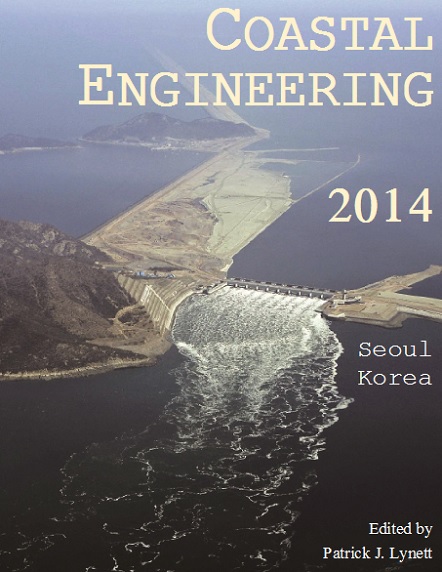Abstract
This paper introduces a numerical approach for the analysis of extreme events of wave interaction with coastal and ma- rine structures. The method is exemplified by investigating oblique wave interactions with a rubble mound breakwater structure. The use of numerical models for analysis of wave-structure interaction is seen more often. For many appli- cations a two-dimensional approximation is valid, however, for investigating complex structural details or e.g. oblique wave interaction with coastal structures, a three-dimensional simulation is required. One challenge for a practical use of three-dimensional simulations is the computational cost. For extreme event analysis it is necessary to determine the characteristics of the extreme events which will occur during an irregular sea state of a given duration. Therefore the complete irregular sea state must be simulated. A three-dimensional simulation of a full irregular sea state with duration of e.g. 3 hours will be a large computational burden. The present work proposes a methodology where the analysis is performed in two steps. 1) A two-dimensional simulation of a full 3 hour irregular sea state is performed including the breakwater structure. The extreme events are observed in terms of loads on the super-structure. 2) The extreme events are reproduced in a three-dimensional model as oblique waves by short realizations. The method was validated by comparing the surface elevation and sea-wall forces from a full irregular sea state to the short reproduction sequences. Good agreement was found for both surface elevation and horizontal sea-wall forces. The short reproduc- tion of extreme events was applied in a three-dimensional setup for investigating the effect of oblique waves. For an incident wave angle of 30â—¦ a reduction of the peak impact load of 25 âˆ' 50 % was found for the tested extreme events.References
Antohe, B. V. and Laget, J. L. (1997). A general two-equation macroscopic turbulence model for incom- pressible flow in porous media. International Journal of Heat and Mass Transfer, 40(13):3013-3024.
Berberovic Ì, E., van Hinsberg, N., Jakirlic Ì, S., Roisman, I., and Tropea, C. (2009). Drop impact onto a liquid layer of finite thickness: Dynamics of the cavity evolution. Physical Review E, 79(3).
Bredmose, H., Peregrine, D. H., and Bullock, G. N. (2009). Violent breaking wave impacts. Part 2: mod- elling the effect of air. Journal of Fluid Mechanics, 641:389.
Bullock, G., Obhrai, C., Peregrine, D., and Bredmose, H. (2007). Violent breaking wave impacts. Part 1: Results from large-scale regular wave tests on vertical and sloping walls. Coastal Engineering, 54(8):602-617.
Burcharth, H. and Andersen, O.H. (1995). On the one-dimensional steady and unsteady porous flow equations. Coastal Engineering, 24(3-4):233-257.
Burcharth, H., Frigaard, P., Uzcanga, J., Berenguer, J., Madrigal, B., and Villanueva, J. (1995). Design of the Ciervana Breakwater.
del Jesus, M., Lara, J. L., and Losada, I. J. (2012). Three-dimensional interaction of waves and porous
coastal structures Part I: Numerical model formulation. Coastal Engineering, 64:57-72.
Engelund, F. (1954). On the laminar and turbulent flows of ground water through homogeneous sand. Technical report, Danish Academy of Technical Sciences.
Forristall, G. Z. (2000). Wave Crest Distributions: Observations and Second-Order Theory. Journal of physical oceanography, pages 1931-1943.
Higuera, P., Lara, J. L., and Losada, I. J. (2014a). Three-dimensional interaction of waves and porous coastal structures using OpenFOAM . Part I: Formulation and validation. Coastal Engineering, 83:243-258.
Higuera, P., Lara, J. L., and Losada, I. J. (2014b). Three-dimensional interaction of waves and porous coastal structures using OpenFOAM . Part II: Application. Coastal Engineering, 83:259-270.
Hsu, T. (2002). A numerical model for wave motions and turbulence flows in front of a composite break-
water. Coastal Engineering, 46(1):25-50.
Jacobsen, N. G., Fuhrman, D. R., and Fredsøe, J. (2012). A wave generation toolbox for the open-source
CFD library : OpenFoam . International Journal for Numerical Methods in Fluids, 70:1073-1088.
Jacobsen, N. G. and Fredsøe, J. (2014). Cross-Shore Redistribution of Nourished Sand near a Breaker Bar.
Journal of Waterway, Port, Coastal, and Ocean Engineering, (March/April):125-134.
Jensen, B., Jacobsen, N. G., and Christensen, E. D. (2014). Investigations on the porous media equations and resistance coefficients for coastal structures. Coastal Engineering, 84:56-72.
Jensen, O. J. (1984). A Monograph on Rubble Mound Breakwaters. Danish Hydraulic Institute, Agern Alle 5, DK-2970 Hoersholm, Denmark.
Lara, J. L., del Jesus, M., and Losada, I. J. (2012a). Three-dimensional interaction of waves and porous coastal structures Part II: Experimental validation. Coastal Engineering, 64:26-46.
Lara, J. L., Higuera, P., Maza, M., del Jesus, M., Losada, I. n. J., and Barajas, G. (2012b). Forces induced on a vertical breakwater by incident oblique waves. In International Conference on Coastal Engineering, pages 1-10.
Liu, P. L.-F., Lin, P., Chang, K.-A., and Sakakiyama, T. (1999). Numerical modeling of wave interaction with porous structures. Journal of Waterways, Port, Coastal and Ocean Engineering, 125:322-330.
Matsumoto, A., Mano, A., Mitsui, J., and Hanzawa, M. (2012). Stability prediction on armor blocks for submerged breakwater by computational fluid dynamics. In International Conference on Coastal Engineering, pages 1-14.
Nakayama, A. and Kuwahara, F. (1999). A macroscopic turbulence model for flow in a porous medium. Journal of fluids engineering, 121(June):427-433.
Schäffer, H., Stolborg, T., and Hyllested, P. (1994). Simultaneous generation and active wave absorption of waves in flumes. In Proc. Int. Symposium: Waves-Physical and Numerical Modelling, pages 90-99. Univ. British Colombia, Vancouver, Canada.
Stahlmann, A. and Schlurmann, T. (2012). Investigations on scour development at tripod foundations for offshore wind turbines: modeling and application. In International Conference on Coastal Engineering, pages 1-11.
van Gent, M. R. A. (1995). Porous Flow through Rubble-Mound Material. Journal of Waterway, Port, Coastal, and Ocean Engineering, 121(3):176-181.
Wellens, P. and van Gent, M. (2012). Wave-induced setup inside permeable structures. In International Conference on Coastal Engineering, pages 1-14.
Zanuttigh, B. and Van der Meer, J. (2006). Wave reflections from coastal structures. In International Conference on Coastal Engineering, pages 1-13.
Zelt, J. A. and Skjelbreia, J. E. (1992). Estimating incident and reflected wave fields using an arbitrary number of wave gauges. In International Conference on Coastal Engineering, pages 777-789.

